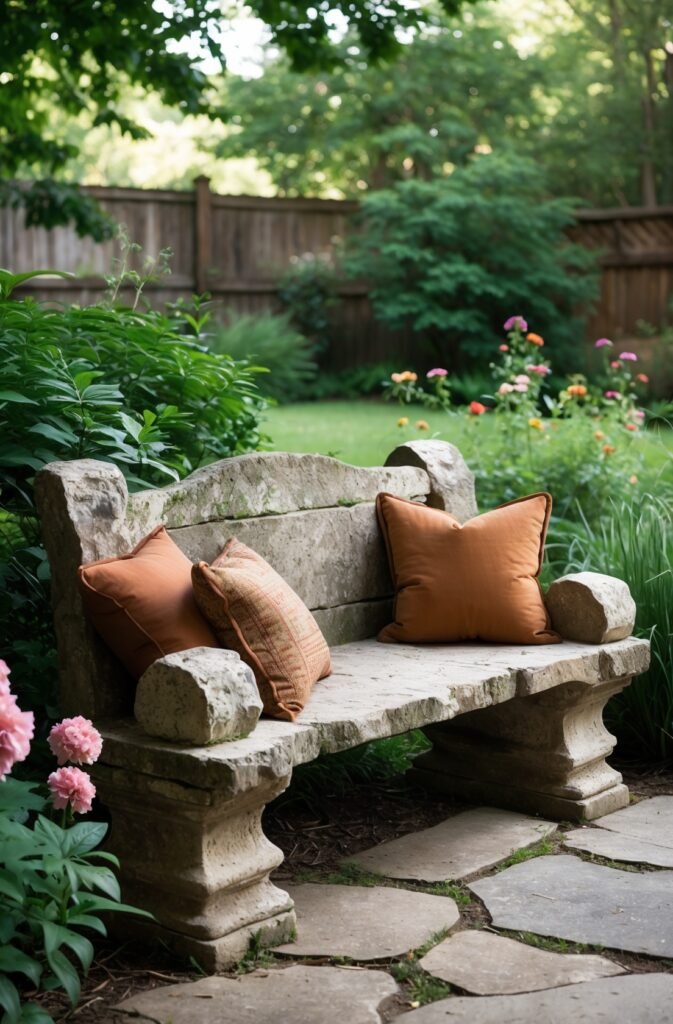
Creating Your Garden Sanctuary: The Enduring Appeal of Stone Benches
In the quest for tranquility and a connection with nature, our gardens often become cherished sanctuaries. A key element in crafting these peaceful outdoor retreats is the choice of seating – a place to pause, reflect, and simply be. Among the myriad options, the stone garden bench stands out for its timeless elegance, durability, and seamless integration into the natural landscape. This image, featuring a beautifully weathered stone bench adorned with warm terracotta cushions amidst lush greenery, perfectly encapsulates the allure of incorporating natural stone into garden design.
Why Choose a Stone Bench?
Stone benches offer a unique blend of aesthetic appeal and practicality that few other materials can match. Let’s explore their advantages:
- Unmatched Durability: Unlike wood that can rot or metal that can rust, stone is incredibly resilient to the elements. A well-crafted stone bench can withstand sun, rain, snow, and frost for decades, often centuries, becoming a permanent fixture in your garden’s story.
- Natural Integration: Stone is an inherent part of the landscape. Whether it’s rugged granite, smooth limestone, or characterful cast stone like the one pictured, it blends harmoniously with plants, soil, and other hardscaping elements like flagstone paths. Its texture and color evolve subtly over time, acquiring moss or lichen, further enhancing its natural charm.
- Timeless Aesthetic: Stone furniture transcends fleeting design trends. Its classic look complements various garden styles, from formal English gardens to rustic cottage settings or even minimalist modern landscapes. The bench in the image, with its carved details and solid form, exudes a sense of history and permanence.
- Low Maintenance: Stone benches require minimal upkeep. An occasional scrub to remove debris or heavy algae growth is usually sufficient. They don’t need sealing, painting, or staining.
Integrating Your Stone Bench: Placement and Styling
Simply acquiring a stone bench isn’t enough; its placement and styling are crucial for creating that desired serene nook. Consider these tips inspired by the featured garden scene:
Strategic Placement
Think about the purpose of the bench. Is it a destination point, a place to admire a specific view, or a quiet spot tucked away for solitude? In the image, the bench is nestled amongst mature plantings, suggesting a secluded retreat. Placing it near fragrant flowers, under the dappled shade of a tree, or overlooking a water feature enhances the sensory experience. Ensure the ground is level and stable; incorporating a flagstone or gravel base, as seen here, provides stability and defines the seating area.
Complementary Planting
Surround your stone bench with plants that soften its edges and integrate it visually. The lush green foliage in the image provides a beautiful contrast to the light grey stone. Consider varying heights and textures – perhaps soft ferns, upright ornamental grasses, or flowering shrubs like the hydrangeas and zinnias visible. Allow plants to gently spill over the edges of the path or brush against the bench for a more natural, established feel.
Adding Comfort and Color
While beautiful, stone isn’t the softest seating material. Adding cushions, like the inviting terracotta ones shown, transforms the bench into a comfortable resting spot. The choice of color here is key – the warm, earthy terracotta provides a striking yet harmonious contrast against the cool stone and vibrant greens. It picks up on potential autumnal tones or complements nearby terracotta pots. When choosing cushions:
- Select Outdoor Fabrics: Opt for materials designed to resist fading, moisture, and mildew.
- Consider Color Palette: Draw inspiration from your garden’s flowers, foliage, or other hardscaping elements. Earthy tones (terracotta, ochre, deep green) often work well with stone.
- Introduce Texture/Pattern: While two cushions are plain, one features a subtle woven pattern, adding another layer of visual interest without overwhelming the scene.
- Remember Practicality: Choose cushions that are easily stored during inclement weather or off-seasons to prolong their lifespan.
Creating Atmosphere
The overall atmosphere is shaped by surrounding elements. The wooden fence in the background provides privacy and a warm, natural backdrop that complements both the stone and the foliage. The irregular flagstone path leads the eye towards the bench, inviting exploration. Natural light filtering through the trees creates dappled patterns, enhancing the sense of peace. For evening enjoyment, consider subtle solar path lights or lanterns nearby.
A Touch of Maintenance
Stone is low-maintenance, but not zero-maintenance. Natural weathering is part of its charm, but you may want to occasionally clean it. Use a stiff brush and water to remove dirt, leaves, or bird droppings. For stubborn algae or moss, specific stone cleaners are available, but always test in an inconspicuous area first. Avoid harsh chemicals or power washers at high pressure, which can damage the stone surface over time.
Your Timeless Garden Feature
A stone garden bench is more than just seating; it’s an investment in enduring beauty and tranquility. As demonstrated by this idyllic scene, careful placement, thoughtful planting, and the simple addition of comfortable, colorful cushions can transform a stone bench into the heart of a serene garden nook. It invites you to slow down, connect with nature, and appreciate the lasting beauty of natural materials in your own backyard sanctuary.
